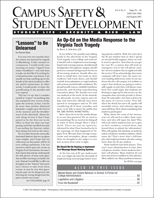Hiding Crime on Campus: Current Reality or Paranoia From the Past?
Author: Dennis E. Gregory Ed.D..
Source: Volume 04, Number 02, November/December 2002 , pp.17-20(4)

< previous article |next article > |return to table of contents
Abstract:
When the Student Right-to-Know and Campus Security Act (Public Law 101–542, 1990) (CleryAct) was passed, it had as its primary intent the provision of information regarding campus crime to students and parents. The individuals who were to be the beneficiaries of these data were either attending American colleges and universities, or were planning to apply for admission. The concept was that this law would provide people seeking admission with an increased ability to make informed decisions about which institution to attend based upon the rates of campus crime. It was also intended to inform current students, so that they could make better decisions about their safety-related behavior on and around campus, in order to avoid victimization. This article discusses reporting of crime on college campuses and why focus should shift to security instead of reporting.Keywords: Student Right-to-Know and Campus Security Act; Security- on-Campus, Inc. (SOC); The Bureau of Justice Statistics (BJS); United States Department of Justice (DOJ);
Affiliations:
1: Contributing Editor to CS&SD.